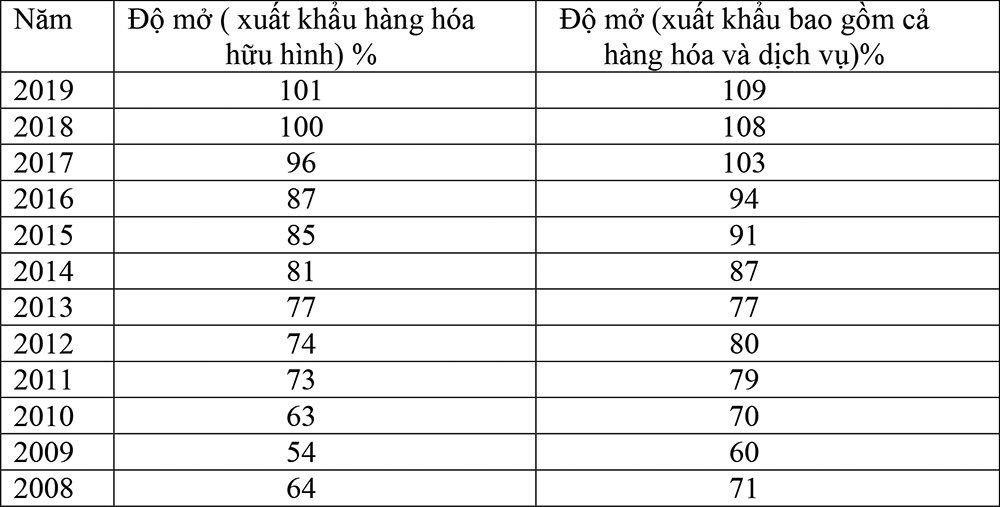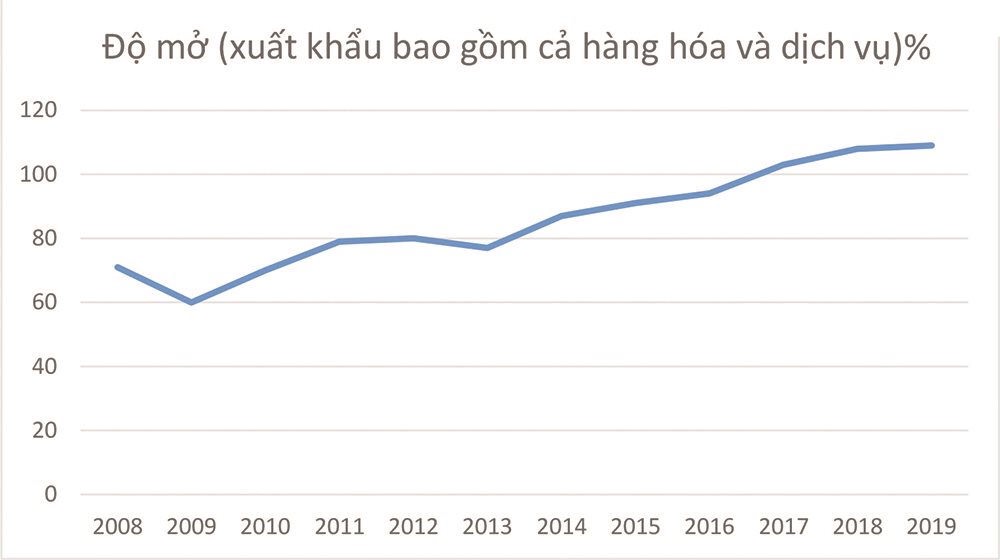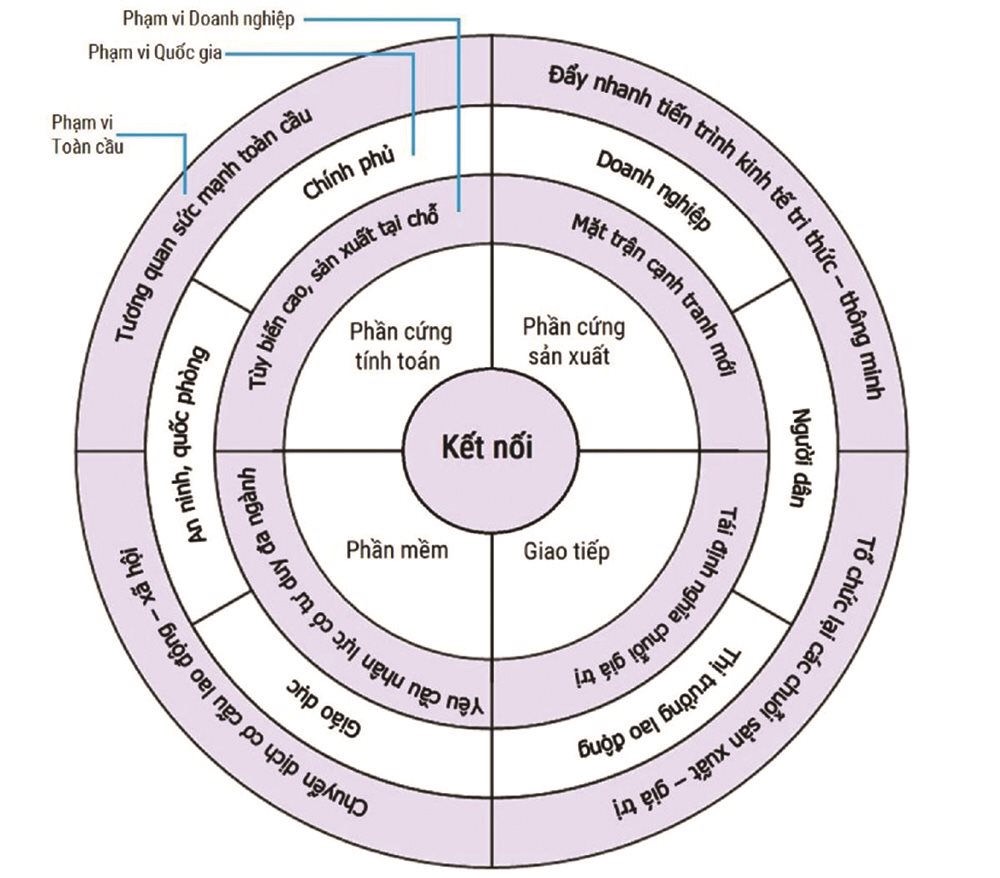The fourth industrial revolution (Industry 4.0) has been taking place rapidly, having a profound impact on all areas of social life, especially the strong economic impact on other sectors. key sectors of the external economy such as international trade, international investment including foreign direct investment (FDI). This situation requires countries and Vietnam to have appropriate analyzes and assessments to best grasp and adapt to this revolution.
Abstract: The 4th Industrial Revolution has been taking place rapidly, having a critical impact on all areas of social life, especially strong impact on economic sectors with key areas of external economy such as international trade, international investment including foreign direct investment (FDI). Over the past 30 years, FDI has played a very important role in changing the economic face of Vietnam and enhancing Vietnam’s position in the region and the world. In the coming time, the orientation of attracting FDI will continue to receive considerable attention from the Government of Vietnam. However, with the strong and diverse impacts of technology (artificial intelligence), the maintaining and promotion of FDI attraction according to the socio-economic development goals of developing countries, including Vietnam will also have to face the effects of 4.0 technology, which will completely change the socio-economic situation, including FDI inflows. This situation requires countries in the world and Vietnam to have appropriate analysis and assessments to best grasp and adapt to this revolution.
1. Overview of the 4th Industrial Revolution
World history has experienced 3 industrial revolutions: the revolution in mechanical production in the late 18th century, the revolution in mass production of goods at the end of the 19th century, and the industrial revolution in the late 18th century. digitization in the 1960s and now is the era of technology 4.0.
Built on a digital platform; This is the revolution, representing new technologies. Industry 4.0 is marked by breakthrough new technologies in several fields including big data, robotics, artificial intelligence (AI), nanotechnology, biotechnology, Internet of Things (IoT), 3D printing , and self-driving cars. This new technology application trend creates completely new possibilities in production and business, having a profound impact on the political, social and economic systems of the world. Global production systems will be interconnected, connected with the power of advanced computational and analytical technologies, connected to low-cost sensor systems through new connectivity methods based on Internet. The explosive growth of advanced manufacturing systems based on digitization and connectivity, also known as “Cyber – physical systems” (CPS), will bring new Products and services are good enough, cheap, plentiful, and plentiful.
2. Features of Industry 4.0 with FDI
First, big data and big data analytics. The connection of accurate and large data from information collection, input data through the use of data analysis software on supercomputer devices to estimate all different data sources.
The characteristics of Big data are: large capacity, high processing speed, variety of types, and potential great value, posing a problem for efficient data processing to exploit the potential of big data. big data, effectively serving the socio-economic tasks of global countries.
At this time, foreign investors will be able to make decisions faster and with a more solid basis than before because they have a massive information system from all angles on the investment environment in the host country, the investment environment in the host country. investment barriers, FDI investors already have in Vietnam market… so that there are solid bases for making investment decisions where to maximize their goals. For example, Samsung Group to make investment decisions before putting the factory in Thai Nguyen of Vietnam has analyzed more than 1000 criteria. It can be said that this is an opportunity but also a challenge for countries including Vietnam.
Second, cloud computing: A computing model that allows access over the network to select and use computing resources according to demand in a convenient and fast way; and at the same time allows to use the service, freeing up resources easily, minimizing communication with the provider. Cloud computing is simply a collection of computing resources and services provided on the web. With services available on the internet, businesses don’t have to buy and maintain hundreds or even thousands of computers and software. They just need to focus on their own business because someone else takes care of the infrastructure and information technology for them. Thus, because the above characteristics are affected, the industry of manufacturing computer components, manufacturing computers, software… may not be able to attract FDI anymore. These are the areas that Vietnam and many developing countries attract the most FDI.
Third, network of things (IoT): Industry 4.0 produces more smart devices. IoT creates convergence between physical applications and digital applications. Along with the popularity of cloud computing technology, IoT enables near-instant global communication and information transmission, which is the premise for the birth of new business models and ways of delivering goods, services that were previously unthinkable. IoT allows humans to monitor the state and activities of physical objects to a very detailed level. From monitoring the flow of products through the plant, measuring moisture in the crop fields, to monitoring the flow of water through pipes, IoT facilitates asset management and optimizes performance, for automation in all areas of life from production to supply of goods, to health care… Thus, the move of manufacturing factories in the form of FDI (greenfield) may no longer exist because of models. All business models are automated, working remotely, providing goods and services without approaching suppliers, at this time, FDI in the field of smart logistics will be stronger.
Fourth, 3D Printing technology: The technology of creating a physical object by gradually accreting layers of material from a pre-existing 3D drawing or model. Companies around the world have begun to use this approach to create new values for the global economy and also change the way it is produced, sold, and consumed.
Additive manufacturing technology is now available in the world, including technology versions such as SLA, FDM, MJM, 3DP, SLS. With industry 4.0,Additive manufacturing will be widely used to produce small pieces of customized products that offer structural advantages.
3D printing technology will change the production model. 3D printing enables the production of finished products by unifying production lines without having to assemble auxiliary equipment and eliminating intermediate production stages and reducing production costs. Thus, if the FDI sector in Vietnam previously always required a network of businesses to supply intermediate products (supporting industries), with 3D printing technology, this factor will no longer play an important role. as important as it is today. Therefore, the development strategy of supporting industries for the FDI sector will have to change in the future. With this point, technology 4.0 helps Vietnam overcome weaknesses that are difficult to remove to meet the requirements of the FDI sector so far.
Bulk products will be replaced by customized products according to individual customer requirements at a cheaper cost. Therefore, entrepreneurs, if they want to make a difference or dominate the market, must focus on developing other aspects of the product, such as design, supply chain as well as service. or associated functions. All of this will entail major changes in business models, product value supply chains as well as customer services. 3D printing technology will cause the need to find cheap labor to be replaced by the demand for workers with creative and highly qualified capabilities and the supply chain closer to the geographical consumption market in order to have can meet all the unique needs of customers in the shortest time.
Fifth, automation: Forecasting experts, Industry 4.0 will drastically change the manufacturing and service industries, especially the application of automated robots or self-propelled equipment in the production process, business and provide services. Visible robotic devices will be present in most factories, in people’s lives, in shops and stores as part of social resources.
Thus, the existing FDI sector in Vietnam mainly uses a lot of cheap labor such as Samsung factories, textile factories… will be replaced by automatic robots. FDI projects using a lot of labor will decrease, which requires Vietnam to adjust policies to attract FDI in the coming time.
Sixth, system convergence: With Industry 4.0, companies and departments become more connected, because the entire information network is homogeneous, helping to make the value chain automatic.
This integration or convergence is linked and connected through software applications, virtual assistant applications, real-time three-dimensional screen interaction space with supporting hardware devices ( 3D projectors, 3D glasses, 3D sounds, smells…) can work remotely but like live. This will form business links between growing multinational companies (MNES) and domestic enterprises receiving investment for business cooperation under the permission and technology transfer of MNEs. without the need for FDI projects to be present in the host country. All technologies will converge and make everything happen in a seamless, easy and multi-dimensional process. This saves time and costs for foreign investors a lot.
This impact occurs not only in a few countries but also on a global scale, including Vietnam. With an increasingly open economy, Vietnam cannot avoid the impact of the Fourth Industrial Revolution on economic fields and external economy, where FDI is a focus of Vietnam’s external economy.
Table: Openness of Vietnam’s economy Chart:
Chart: Openness of Vietnam’s economy 2008-2019
Seventh, technology 4.0 with the shift of FDI factories: Industry 4.0 will promote the development of the economy knowledge economy, creating a smart society. New achievements of science and technology are applied to optimize production, management and consumption processes such as smart infrastructure, smart construction, smart chain, smart products, smart management… With the development of digitization of production, natural resources, and low-cost unskilled labor are increasingly losing their advantages; production is moving from countries with a lot of unskilled workers and natural resources to countries with lots of high-skilled workers and close to consumption markets. In the future, the driving force of economic growth will be technological innovation and creativity.
Technology 4.0 has four impacts on businesses, including: (1) on customer expectations; (2) on improving product quality; (3) on cooperative innovation; (4) on organizational forms. The pace of innovation and the resulting disruptions have continually surprised even the best-connected and best-informed businesses. On the supply side, across many industries, technologies are emerging that create entirely new ways of meeting current needs and significantly disrupt existing industrial value chains. Huge demand-side changes are also happening, as is increasing transparency Rising consumer participation, and new patterns of consumer behavior (increasingly built on access to mobile networks and data) force companies to adapt to how they design, market, and deliver products and services. Thereby creating the development of new technology platforms, allowing the combination of supply and demand to disrupt existing industry structures, such as those in the “sharing” or “follow-up” economy. request”.
Creative industries have grown faster than traditional manufacturing and service industries. The main driver of this growth is the strong development of multimedia and telecommunications technology, especially the development of mobile phones.
Manufacturing technology is based on new technology, new application technology has gradually blurred the boundaries between stages in the production process. Industry 4.0 fundamentally changes the way of production. Previously, factories were moved to places with low labor costs to assemble components and details, but in Industry 4.0, labor is no longer used much, assembly and processing stages are changed. Replaced by robots, labor costs become less important. Therefore, it is possible to forecast the shift of factories of large corporations from the ASEAN region or China to developed countries to be close to the consumption market.
Industry 4.0 is creating great opportunities for startups in the field of technology and creativity. The initial investment may not be large, but it brings high and fast profits. The wave of FDI in the world will change industries to invest more in technology and innovation instead of the current processing industry.
Eighth, technology 4.0 with the employment structure of the FDI sector in the host country. Industry 4.0 promotes the transformation of social labor structure in many countries. In which, more and more classes and creative classes appear in the fields of science, technology, design, art, culture, entertainment, media, education, and health.
Industry 4.0 affects the structure of employment in general and thus also affects the employment of the foreign-invested sector. In the short term, unemployment may increase in simple manufacturing industries (assembling, textiles…). It should be noted that the vast majority of FDI enterprises account for a strong export proportion of up to 70% in the textile and garment sector in Vietnam. Workers will have to move from simple manufacturing industries to new industries. However, in the long term, Industry 4.0 will have a direct impact on industries that use a lot of low-skilled workers, as labor is gradually replaced by automatic control systems and intelligent robots.
Ninth, technology 4.0 with the state of environmental pollution of FDI enterprises.
Many researchers consider the impacts of Industry 4.0 on the environment to be positive thanks to technologies that save energy, materials and are environmentally friendly. Environmental monitoring technologies are also developing rapidly, and are also supported by the Internet of Things, which helps to collect and process information continuously 24/7 in real time, for example through means such as Unmanned aerial vehicles connected by the Internet are equipped with cameras and sensors capable of collecting the necessary data for surveillance. Therefore, FDI projects in the future will be forced to apply 4.0 technology and thus, reduce environmental pollution, which is still caused to the host countries but for the sake of profit that foreign investors have. Foreigners often evade the obligation to protect the living environment in the host country.
Tenth, 4.0 technology with production of FDI enterprises: Some developed countries such as the US, Germany … are in a favorable position to lead the trend of Industry 4.0. If the implementation is as successful as the current projections are, then from around the mid-2020s, developed countries will have a big impetus to boost growth and improve competitiveness. Political-economic power will belong to countries that create and master core production technologies, not countries that possess a lot of resources and labor. Therefore, if developing countries fail to take advantage of these technologies, the gap with developed countries will widen.
Over the past time, emerging economies have significantly narrowed the gap with developed countries in terms of economic scale (in quantity), but the gap in science – technology and institutional quality (in terms of quality). still big. If emerging economies do not reform deeply in economic and social institutions to create an effective economy and encourage innovation and creativity, it will be difficult to catch up with developed countries. Therefore, continuing to increase FDI attraction in the high-tech sector is still a very important goal of developing countries, including Vietnam, but it will be more difficult because of the shift in capital flows. In contrast, developed countries that are already strong will be stronger with the mastery of 4.0 technology.
Eleven, 4.0 technology changes the thinking and reorganizes the production and value chains of FDI enterprises on a global scale. With high integration and flexibility, Industry 4.0 gradually erases the boundaries between stages/stages and production processes, especially the stages of designing, processing and assembling manufactured products, changing the basis of manufacturing processes. The way people create products, thereby creating a “revolution” in the organization of production – value chains. Figure 2: Direct impact of Industry 4.0 on production and business in general, including FDI enterprises.
Twelve, promoting labor-society restructuring. Industry 4.0 is accelerating labor restructuring in many countries. An increasing number of creative classes/classes are appearing in the fields of science, technology, design, art, culture, entertainment, media, education and training, healthcare, and law. Along with the development of Industry 4.0 and the creative economy, creative workers increasingly occupy a leading position in the social workforce. Thus, FDI inflows will also lead to a change in the investment sector.
Thirteen, 4.0 technology with the advantage of cheap raw materials of host countries. In the past, developing countries were the places to attract FDI based on the advantages of cheap raw materials and low labor costs. However, this will gradually disappear because these countries themselves no longer have these advantages (subjective) and because Industry 4.0 has changed the economic structure and investment on a worldwide scale, including: the developing countries. Developing countries need to focus on FDI orientations and policies to adapt to the context of the technological revolution.
3. Some suggestions
In order to adapt well to the changes of FDI inflows due to the reason from the 4.0 Industrial Revolution, it is necessary to have appropriate solutions, the author makes some macro proposals as follows:
Firstly, FDI-receiving countries actively diversify their industries, in which, focus is on shifting to occupations with high brain-intensive labor. This is very important to be able to prepare for the needs of foreign investors during the transition due to the impact of Industry 4.0.
Second: Having a strategy to catch up with FDI inflows changing according to technology 4.0 in line with the development goals of their country. The competitive pole is tilted towards developed countries where source technology is kept and still have advantages in Industry 4.0, requiring developing countries including Vietnam to proactively improve their strategies to attract foreign investors. FDI associated with 4.0 technology to put into practice as soon as possible.
Third: Continue to review and supplement and adjust international trade policies and international investment policies of countries taking into account the impacts of Industry 4.0. Vietnam already has an Investment Law in 2020, however, it is necessary to consider more policy tools to attract FDI in line with the inevitable trend of the 4.0 technology revolution. By this time, it is necessary to have the constituent policies of international investment policy, including incentives, encouragement of investment fields, and new investment promotion policies associated with the context of 4.0.
Source : Thi Truong Tai Chinh Tien Te

 EN
EN VI
VI























